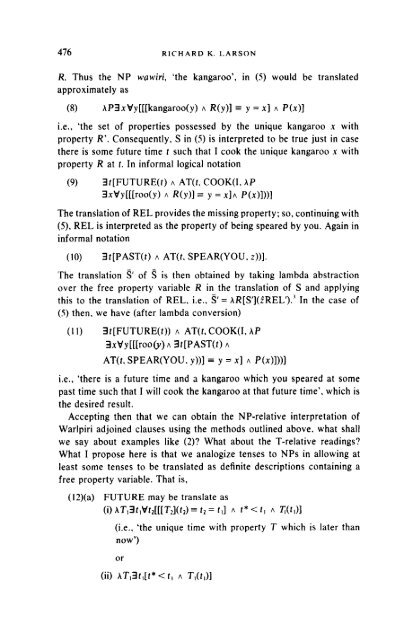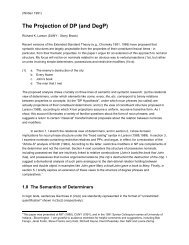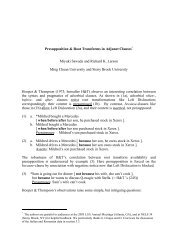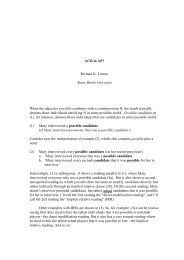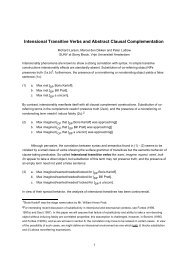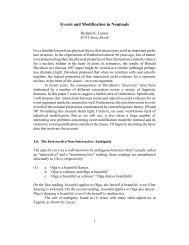A note on the interpretation of adjoined relative clauses
A note on the interpretation of adjoined relative clauses
A note on the interpretation of adjoined relative clauses
You also want an ePaper? Increase the reach of your titles
YUMPU automatically turns print PDFs into web optimized ePapers that Google loves.
476 RICHARD K. I.ARSON<br />
R. Thus <strong>the</strong> NP wawiri, '<strong>the</strong> kangaroo', in (5) would be translated<br />
approximately as<br />
(8) •P=lxVy[[[kangaroo(y) ^ R(y)] = y = x] ^ P(x)]<br />
i.e., '<strong>the</strong> set <strong>of</strong> properties possessed by <strong>the</strong> unique kangaroo x with<br />
property R'. C<strong>on</strong>sequently. S in (5) is interpreted to be true just in case<br />
<strong>the</strong>re is some future time t such that I cook <strong>the</strong> unique kangaroo x with<br />
property R at t. In informal logical notati<strong>on</strong><br />
(9) ::It[FUTURE(t) ^ AT(t, COOK(I, hP<br />
::lxVy[[[roo(y) A R(y)] ~ y = x]^ P(x)]))]<br />
The translati<strong>on</strong> <strong>of</strong> REL provides <strong>the</strong> missing property; so, c<strong>on</strong>tinuing with<br />
(5), REL is interpreted as <strong>the</strong> property <strong>of</strong> being speared by you. Again in<br />
informal notati<strong>on</strong><br />
(10) ::It[PAST(t) A AT(t, SPEAR(YOU, z))].<br />
The translati<strong>on</strong> S' <strong>of</strong> S is <strong>the</strong>n obtained by taking lambda abstracti<strong>on</strong><br />
over <strong>the</strong> free property variable R in <strong>the</strong> translati<strong>on</strong> <strong>of</strong> S and applying<br />
this to <strong>the</strong> translati<strong>on</strong> <strong>of</strong> REL, i.e., S'= ,~R[S'](~REL'). 3 In <strong>the</strong> case <strong>of</strong><br />
(5) <strong>the</strong>n, we have (after lambda c<strong>on</strong>versi<strong>on</strong>)<br />
(I 1) ::It[FUTURE(t)) ^ AT(t, COOK(I, AP<br />
::lxVy[[[roo(y) A ::It[PAST(t) A<br />
AT(t, SPEAR(YOU, y))] -- y = x] ^ P(x)]))]<br />
i.e., '<strong>the</strong>re is a future time and a kangaroo which you speared at some<br />
past time such that I will cook <strong>the</strong> kangaroo at that future time', which is<br />
<strong>the</strong> desired result.<br />
Accepting <strong>the</strong>n that we can obtain <strong>the</strong> NP-<strong>relative</strong> interpretati<strong>on</strong> <strong>of</strong><br />
Warlpiri <strong>adjoined</strong> <strong>clauses</strong> using <strong>the</strong> methods outlined above, what shall<br />
we say about examples like (2)? What about <strong>the</strong> T-<strong>relative</strong> readings?<br />
What I propose here is that we analogize tenses to NPs in allowing at<br />
least some tenses to be translated as definite descripti<strong>on</strong>s c<strong>on</strong>taining a<br />
free property variable. That is,<br />
(12)(a)<br />
FUTURE may be translate as<br />
(i) ATz3tlVt2[[[T2](t2) =- t2 = h] A t* < t~ ^ Tl(h)]<br />
(i.e., '<strong>the</strong> unique time with property T which is later than<br />
now')<br />
or<br />
(ii) ,XTj3td.t*< t~ A T~(t~)]


